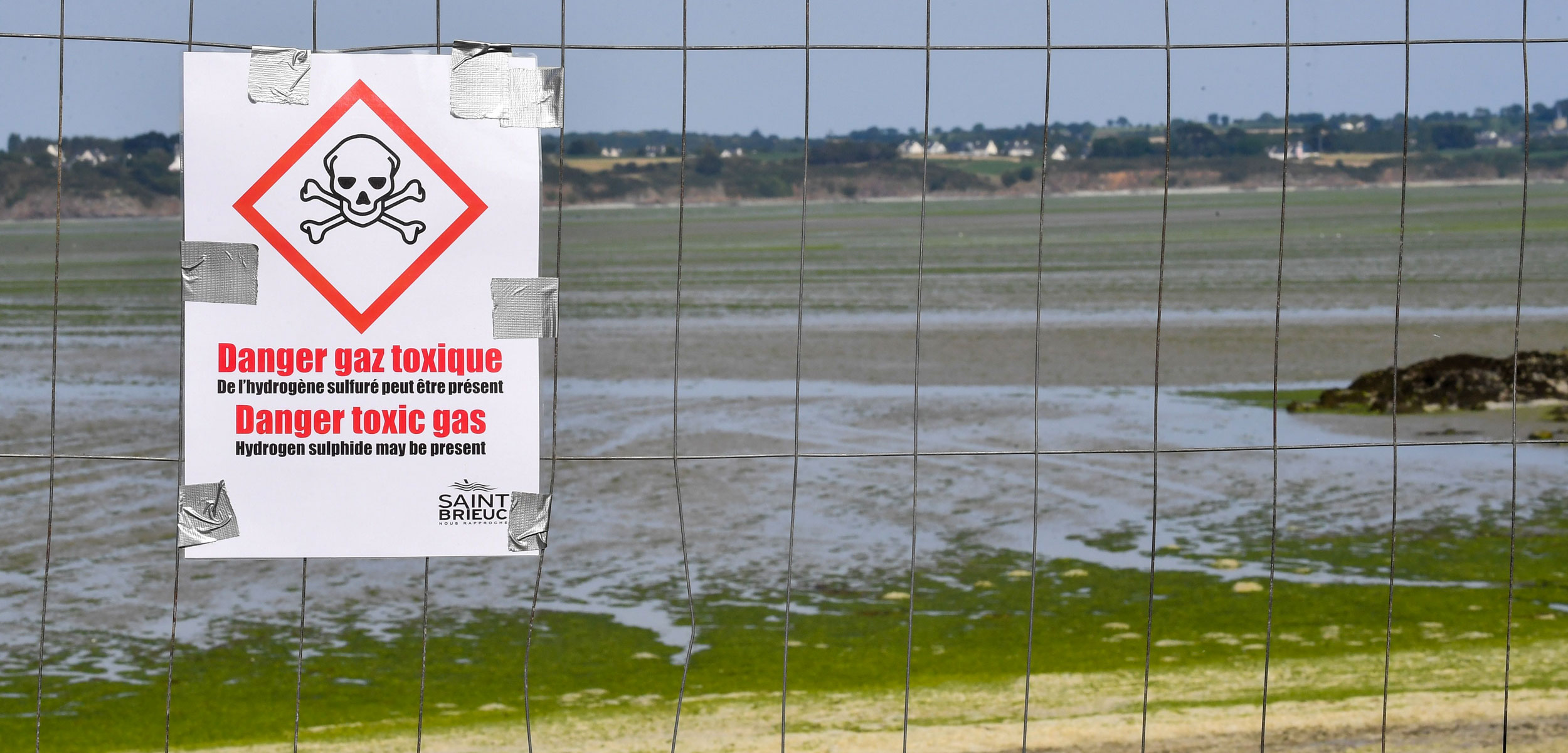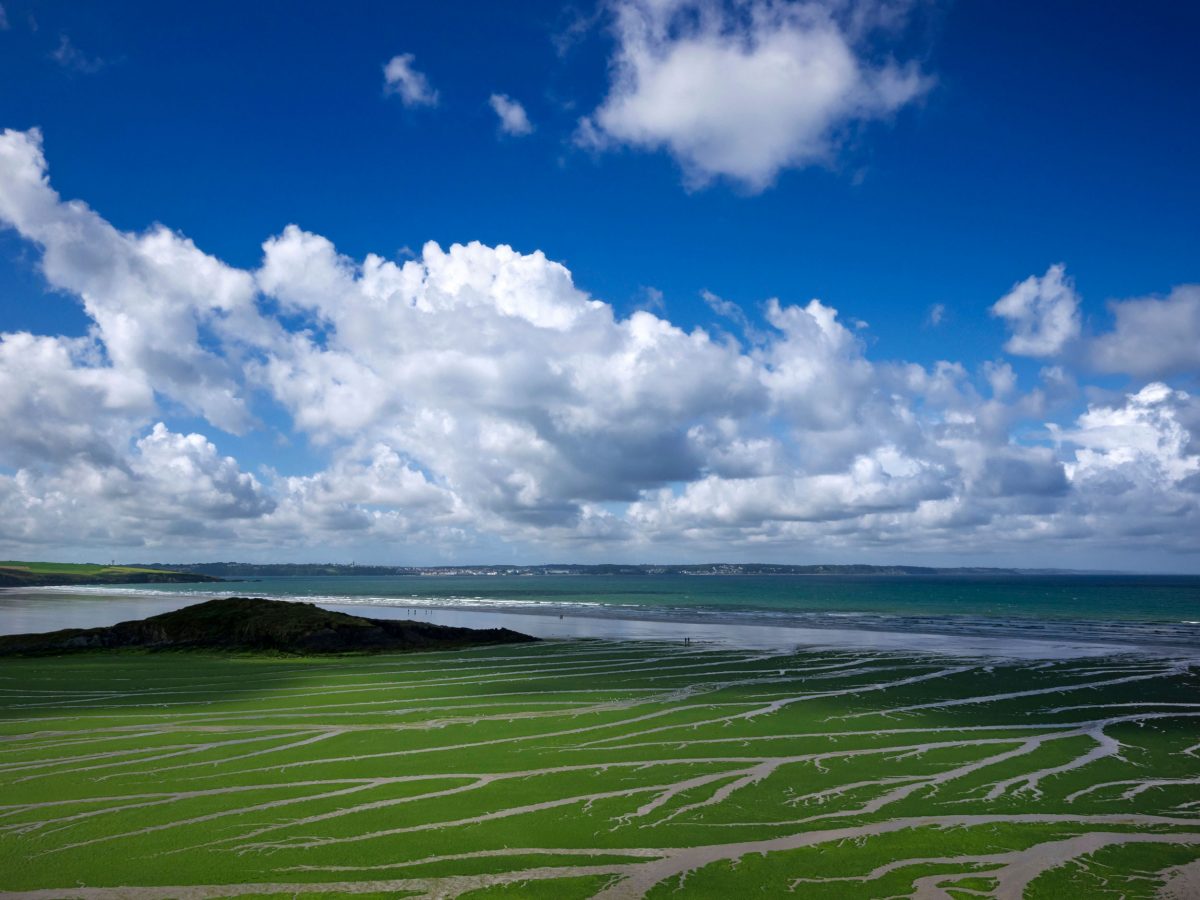Welcome to DU!
The truly grassroots left-of-center political community where regular people, not algorithms, drive the discussions and set the standards.
Join the community:
Create a free account
Support DU (and get rid of ads!):
Become a Star Member
Latest Breaking News
General Discussion
The DU Lounge
All Forums
Issue Forums
Culture Forums
Alliance Forums
Region Forums
Support Forums
Help & Search
Environment & Energy
Related: About this forumHuge Algae Blooms, Driven By Runoff, Turning Brittany Beaches Deadly; H2S Suspected In 6 Deaths

Several beaches in Brittany, France, were closed last summer due to a toxic green tide that may have killed three people. Photo by Loic Venance/AFP via Getty Images
André Ollivro has spent years stomping around the beaches of Brittany, France, putting on a show for the cameras. Sometimes he wears a gas mask and carries a hydrogen sulfide monitor. On other occasions, a pitchfork and wheelbarrow serve as props. He’s often in a red cap and always fiery about the scourge of green algae, which, for decades, have encrusted the bays of Brittany. For nearly 20 years now, the retired engineer and head of the environmental group whose name translates to Stop the Green Tides has played a sort of Chicken Little to the French region’s disinterested masses.
“The beaches are becoming landfills,” Ollivro says. “Landfills of rotting green algae that kill the living.” Included among those he says have succumbed to the green tide: dozens of wild hogs, several domestic dogs, a horse, and as many as six people, including three in the summer of 2019, although the precise cause of the human deaths has not been conclusively confirmed. (A blood test that can detect hydrogen sulfide intoxication was not carried out in the autopsies.)
The presumed killer is commonly called sea lettuce, an apt name for algae that resemble emerald-green plastic wrap. The two main species that grow along the Breton coast—Ulva armoricana and Ulva rotundata—live attached to the rocks of the intertidal zone. When the fronds break free of their mooring, they continue to grow while floating through the water. The algae are native to the region, and are ubiquitous, but in the 1970s things started to change.

Sea lettuce, the common name for a genus of algae called Ulva, blankets the Baie de Douarnenez in Brittany, France. Photo by ImageBroker/Alamy Stock Photo
Since then, each spring and summer, unusually large masses of the seaweeds have festooned swaths of the shoreline. The carpet sometimes thickens to a meter, completely obscuring the sand. Once the Ulva starts decaying, it stinks of rotten eggs and emits hydrogen sulfide, which is thought to be responsible for the mammalian deaths. When people or animals walk on the seaweed sludge, perhaps assuming it’s safe because of the dried brown crust, they break through to the decaying organic matter below and release the noxious gas. Ollivro blames one industry for the algal menace: intensive agriculture. Nitrogen from fertilizer and animal waste runs into the region’s rivers and out to sea, creating an all-you-can-eat buffet for the algae, which grow in profusion with the extra nutrients. Between 2007 and 2018, green tides hit a total of 114 different sites along the coast, with the algal accumulations from that time covering an area equal to 601 soccer stadiums.
EDIT
https://www.hakaimagazine.com/features/frances-deadly-seaweed/
InfoView thread info, including edit history
TrashPut this thread in your Trash Can (My DU » Trash Can)
BookmarkAdd this thread to your Bookmarks (My DU » Bookmarks)
2 replies, 581 views
ShareGet links to this post and/or share on social media
AlertAlert this post for a rule violation
PowersThere are no powers you can use on this post
EditCannot edit other people's posts
ReplyReply to this post
EditCannot edit other people's posts
Rec (4)
ReplyReply to this post
2 replies
 = new reply since forum marked as read
Highlight:
NoneDon't highlight anything
5 newestHighlight 5 most recent replies
= new reply since forum marked as read
Highlight:
NoneDon't highlight anything
5 newestHighlight 5 most recent replies
Huge Algae Blooms, Driven By Runoff, Turning Brittany Beaches Deadly; H2S Suspected In 6 Deaths (Original Post)
hatrack
Feb 2020
OP
I_UndergroundPanther
(12,480 posts)1. There is a website that goes in
Depth about the situation with toxic algae and Hydrogen Sulphide.
http://jumpingjackflashhypothesis.blogspot.com/?m=1
hunter
(38,337 posts)2. Well, that's terrifying...
http://jumpingjackflashhypothesis.blogspot.com/2012/02/jumping-jack-flash-hypothesis-its-gas.html
We knew we had to quit fossil fuels in the 'seventies but there were too many very powerful people making too much money.
That's still the case.
There are enough fossil fuels still in the ground, especially "natural" gas, to destroy the earth as we know it.
That is an indisputable fact.
The only way to quit fossil fuels is to quit fossil fuels! We can then deal thoughtfully with the economic consequences that follow. There's no technology that will magically displace fossil fuels; no invisible hand of the free market will save us.
Here is an article from The Atlantic covering the same topic as your link:
We knew we had to quit fossil fuels in the 'seventies but there were too many very powerful people making too much money.
That's still the case.
There are enough fossil fuels still in the ground, especially "natural" gas, to destroy the earth as we know it.
That is an indisputable fact.
The only way to quit fossil fuels is to quit fossil fuels! We can then deal thoughtfully with the economic consequences that follow. There's no technology that will magically displace fossil fuels; no invisible hand of the free market will save us.
Here is an article from The Atlantic covering the same topic as your link:
When a Killer Climate Catastrophe Struck the World's Oceans
The worst extinction in Earth’s history offers chilling predictions for the planet’s future—and for humanity’s efforts to keep climate doom at bay.
Identifying a killer can be difficult when it seems like every murder weapon imaginable has been used in the crime, and when the victim is the entire planet. About 252 million years ago, a rich and wonderful world was annihilated in the worst mass extinction ever: the end-Permian, a catastrophe with no close competitor in Earth’s history. Volcanoes of a truly preposterous scale erupted in Siberia over many thousands of years, loosing all manner of chaos on the world. Rounding up, everything died.
--more--
https://www.theatlantic.com/science/archive/2018/12/oxygen-loss-during-mass-extinction/577537/
The worst extinction in Earth’s history offers chilling predictions for the planet’s future—and for humanity’s efforts to keep climate doom at bay.
Identifying a killer can be difficult when it seems like every murder weapon imaginable has been used in the crime, and when the victim is the entire planet. About 252 million years ago, a rich and wonderful world was annihilated in the worst mass extinction ever: the end-Permian, a catastrophe with no close competitor in Earth’s history. Volcanoes of a truly preposterous scale erupted in Siberia over many thousands of years, loosing all manner of chaos on the world. Rounding up, everything died.
--more--
https://www.theatlantic.com/science/archive/2018/12/oxygen-loss-during-mass-extinction/577537/